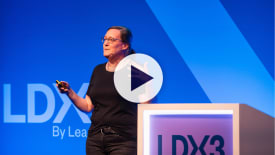Register or log in to access this video
Tired of inaccurate estimations that become commitments? Learn how we transitioned from spending endless hours providing (faulty) estimates to getting to probabilistic forecasting, backed by historical data and risk of failure.
Engineering leaders constantly battle inaccurate estimates that morph into rigid deadlines. We wasted countless hours trying to find the ‘perfect’ number, yet projects consistently missed targets. So we decided to try something radically different.
This talk shares our company’s transformative journey away from traditional estimation toward data-driven, probabilistic forecasting. I’ll present actual metrics and visualizations from our engineering organization that demonstrate how this shift dramatically improved our delivery predictability and stakeholder relationships. You’ll see the before-and-after comparisons, including charts contrasting our story point estimates against actual cycle times.
Our case studies reveal why focusing on individual task estimates failed to account for the inherent randomness and dependencies in our systems, factors that repeatedly derailed our carefully planned projects. I’ll share how we implemented Flow Metrics and Monte Carlo Simulations across our engineering teams, the resistance we encountered, and how we now spend 60% less time on estimation activities while delivering more reliable forecasts. Most importantly, you’ll learn how this approach empowered our Engineering Managers to communicate delivery risks effectively to stakeholders.
You will discover:
- Why traditional estimation methods fall short in unpredictable environments – with real data showing the gap between estimates and actuals
- Why we need to distinguish work analysis from estimation exercise
- Our three-tiered estimation approach based on planning horizons (annual roadmap, quarterly planning, sprint commitments)
- Simple techniques we use to visualize and communicate forecast confidence and risk
- Leave equipped with actionable methods to move beyond guesswork and answer ‘When will it be done?’ with data-backed insights and appropriate confidence levels.
Key takeaways
- Learn practical methods, using your existing data, to predict delivery ranges and communicate forecast confidence.
- See real data showing how our team’s estimates compared to actual cycle times and why this gap existed.
- Learn why historical data beats (guess)estimates
- Work analysis is not the same as a ballpark estimation
- Discover our practical three levels of forecasting for different planning horizons (annual roadmaps, quarterly planning, sprint commitments)
- Implement basic probabilistic forecasting techniques that engineering managers can use without specialized tools (AI can do this for you!)





